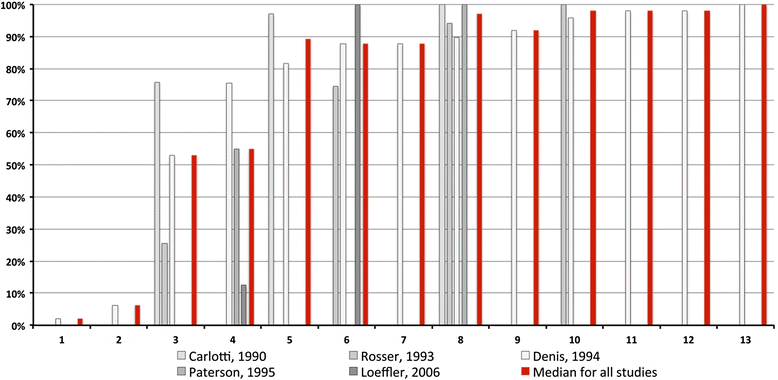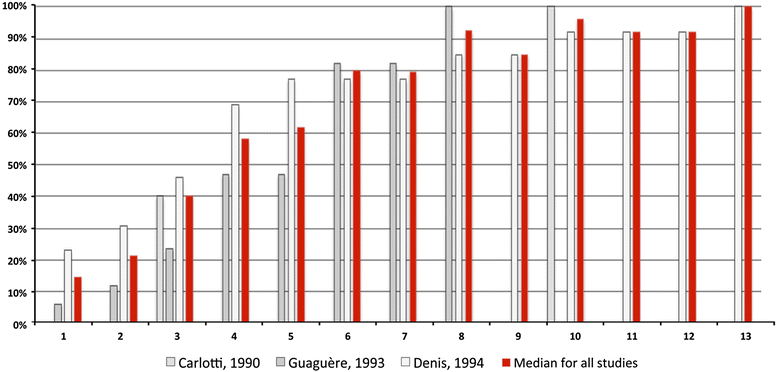Critically appraised topic on adverse food reactions of companion animals (1): duration of elimination diets
- PMID: 26310322
- PMCID: PMC4551374
- DOI: 10.1186/s12917-015-0541-3
Critically appraised topic on adverse food reactions of companion animals (1): duration of elimination diets
Abstract
Background: Restrictive (i.e. elimination)-provocation dietary trials remain the standard of care to diagnose cutaneous adverse food reactions (CAFRs) in dogs and cats. There is currently no consensus on the duration of elimination diet trials that would permit the highest sensitivity of diagnosis of CAFR in companion animals.
Results: The search for, and review and analysis of the best evidence available as of December 14, 2014 suggests that, by 5 weeks in dogs and 6 weeks in cats after starting an elimination diet, more than 80 % of patients had achieved a remission of clinical signs of CAFR. Increasing the diet trial duration to 8 weeks leads to a complete remission in more than 90 % of dogs and cats with CAFR.
Conclusions: For diagnosing CAFRs in more than 90 % of dogs and cats, elimination diet trials should last at least 8 weeks.
Figures
Similar articles
-
Critically appraised topic on adverse food reactions of companion animals (2): common food allergen sources in dogs and cats.BMC Vet Res. 2016 Jan 12;12:9. doi: 10.1186/s12917-016-0633-8. BMC Vet Res. 2016. PMID: 26753610 Free PMC article.
-
Adverse food reactions in dogs and cats.Vet Clin North Am Small Anim Pract. 2011 Mar;41(2):361-79. doi: 10.1016/j.cvsm.2011.02.005. Vet Clin North Am Small Anim Pract. 2011. PMID: 21486641 Review.
-
Critically appraised topic on adverse food reactions of companion animals (3): prevalence of cutaneous adverse food reactions in dogs and cats.BMC Vet Res. 2017 Feb 15;13(1):51. doi: 10.1186/s12917-017-0973-z. BMC Vet Res. 2017. PMID: 28202060 Free PMC article. Review.
-
Critically appraised topic on adverse food reactions of companion animals (4): can we diagnose adverse food reactions in dogs and cats with in vivo or in vitro tests?BMC Vet Res. 2017 Aug 30;13(1):275. doi: 10.1186/s12917-017-1142-0. BMC Vet Res. 2017. PMID: 28854915 Free PMC article.
-
Critically appraised topic on adverse food reactions of companion animals (9): time to flare of cutaneous signs after a dietary challenge in dogs and cats with food allergies.BMC Vet Res. 2020 May 24;16(1):158. doi: 10.1186/s12917-020-02379-3. BMC Vet Res. 2020. PMID: 32448251 Free PMC article. Review.
Cited by
-
Critically appraised topic on adverse food reactions of companion animals (6): prevalence of noncutaneous manifestations of adverse food reactions in dogs and cats.BMC Vet Res. 2018 Nov 12;14(1):341. doi: 10.1186/s12917-018-1656-0. BMC Vet Res. 2018. PMID: 30419909 Free PMC article.
-
Enterocytes in Food Hypersensitivity Reactions.Animals (Basel). 2021 Sep 17;11(9):2713. doi: 10.3390/ani11092713. Animals (Basel). 2021. PMID: 34573679 Free PMC article.
-
Extensive protein hydrolyzation is indispensable to prevent IgE-mediated poultry allergen recognition in dogs and cats.BMC Vet Res. 2017 Aug 17;13(1):251. doi: 10.1186/s12917-017-1183-4. BMC Vet Res. 2017. PMID: 28818076 Free PMC article.
-
Black Soldier Fly (Hermetia illucens) Larvae as a Protein Substitute in Adverse Food Reactions for Canine Dermatitis: Preliminary Results Among Patients.Vet Sci. 2025 Jan 17;12(1):68. doi: 10.3390/vetsci12010068. Vet Sci. 2025. PMID: 39852943 Free PMC article.
-
Standardization of Beef, Pork, Chicken, and Soy Protein Extracts for Patch Testing and Their Accuracy in Diagnosing Adverse Food Reactions in Dogs with Chronic Pruritus.Vet Sci. 2025 Apr 18;12(4):383. doi: 10.3390/vetsci12040383. Vet Sci. 2025. PMID: 40284886 Free PMC article.
References
-
- Rosser EJ. Diagnosis of food allergy in dogs. J Amer Vet Med Assoc. 1993;203:259–62. - PubMed
-
- Denis S, Paradis M. L'allergie alimentaire chez le chien et le chat. 2. Etude rétrospective (food allergy in dogs and cats. 2. retrospective study) Méd Vét Québec. 1994;24:15–20.
MeSH terms
LinkOut - more resources
Full Text Sources
Other Literature Sources
Medical
Miscellaneous



